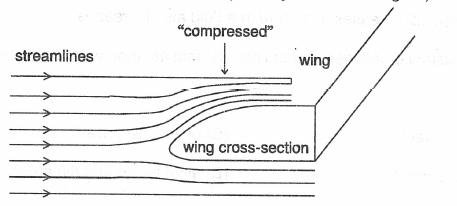Example
Inferring pressure at a point from density of streamlines

Example: Consider an airplane moving through the air at velocity . The streamlines which move just over the top are compressed to eight-tenths their normal area and given that those under the wing are not compressed at all (Density of air ). What is the difference in the pressure between the air just over the wing and that under the wing ?
Solution:Compression of the streamlines means that the stream tube above the wing
has a smaller cross-sectional area than that in front of the plane and from the continuity equation , the velocity of the air must, therefore, be greater above the wing. Area
From continuity equation,
The greater velocity (,as obtained above) implies lower pressure than the normal pressure of the air in front of the plane. Given that the flow-lines under the wing are not compressed at all.
The pressure under the wing is just the normal pressure of the air in front of the wing.
From Bernoulli's equation , with both points 1 (for ) and 2 (for ) at effectively same elevation.
Given:
Solution:Compression of the streamlines means that the stream tube above the wing
has a smaller cross-sectional area than that in front of the plane and from the continuity equation , the velocity of the air must, therefore, be greater above the wing. Area
From continuity equation,
The greater velocity (,as obtained above) implies lower pressure than the normal pressure of the air in front of the plane. Given that the flow-lines under the wing are not compressed at all.
The pressure under the wing is just the normal pressure of the air in front of the wing.
From Bernoulli's equation , with both points 1 (for ) and 2 (for ) at effectively same elevation.
Given:
Definition
Direction of force on a surface in a static fluid

Force inside the static fluid acts perpendicular to the surfaces of fluid column. The direction of force on the top and bottom of a liquid column in a fluid column is shown in the attached figure as and .
Example
Problem on U-tube containing immisible liquids

Example: The relative density of the liquid at the bottom of the U-tube is 11.
Water is filled over it as shown. What is the difference in the liquid level in
the U-tube?
Solution: By Pascal's law of pressure at equal level of fluid will have same value.
Water is filled over it as shown. What is the difference in the liquid level in
the U-tube?
Solution: By Pascal's law of pressure at equal level of fluid will have same value.
Example
Force balance equation in static fluids
Example:
If the acceleration due to gravity is , a sphere of lead of density is gently released in a column of liquid of density , the sphere will fall vertically with what acceleration?
Solution:Force due to gravity
Where is the Volume of the Sphere , is the density of the sphere and is the acceleration due to gravity .
Force due to buoyancy where is the density of the liquid .
Net Force
Net acceleration
If the acceleration due to gravity is , a sphere of lead of density is gently released in a column of liquid of density , the sphere will fall vertically with what acceleration?
Solution:Force due to gravity
Where is the Volume of the Sphere , is the density of the sphere and is the acceleration due to gravity .
Force due to buoyancy where is the density of the liquid .
Net Force
Net acceleration
Example
Hollow sphere immersed in liquids

Example: A hollow sphere of mass and radius is immersed in a tank of water (density ). The sphere would float if it were set free. The sphere is tied to the bottom of the tank by two wires which makes angle with the horizontal as shown in the figure. Find the tension in the wires?
Solution:When the sphere is tied to the strings, it is in equilibrium. net force
on sphere is zero. i.e. net upward force= net downward force
; here is the buoyant force
Solution:When the sphere is tied to the strings, it is in equilibrium. net force
on sphere is zero. i.e. net upward force= net downward force
; here is the buoyant force
Example
Objects immersed in multiple Immiscible static fluids

Example: A container of a large uniform cross-sectional area resting on horizontal surface holds two immiscible,non-viscous and incompressible liquids of densities and each of height as shown in the figure. The lower density liquid is open to atmosphere. A homogeneous solid cylinder of length cross-sectional area is immersed such that it floats with its axis vertical of the liquid-liquid interface with length in the denser liquid. Find force balance equation on the object.
The total pressure at the bottom of the container is given as . Find (atmospheric pressure
Solution:
Total pressure at the bottom of cylinder is
Here we are asked to find the total pressure at the bottom of the container and
not only the hydrostatic pressure; hence, we need to consider the total weight of the liquid and cylinder in the container.
The total pressure at the bottom of the container is given as . Find (atmospheric pressure
Solution:
Total pressure at the bottom of cylinder is
Here we are asked to find the total pressure at the bottom of the container and
not only the hydrostatic pressure; hence, we need to consider the total weight of the liquid and cylinder in the container.
| BookMarks |
Page 11 Page 12 Page 13 Page 14 Page 15 Page 16 Page 17 Page 18
0 Comments
Post a Comment